Marketing Essentials: Unilever Marketing Plan Analysis
VerifiedAdded on 2022/12/28
|18
|4300
|77
AI Summary
This report analyzes the marketing plan of Unilever, a British multinational company, and evaluates different tactics applied by organizations to achieve business objectives.
Contribute Materials
Your contribution can guide someone’s learning journey. Share your
documents today.
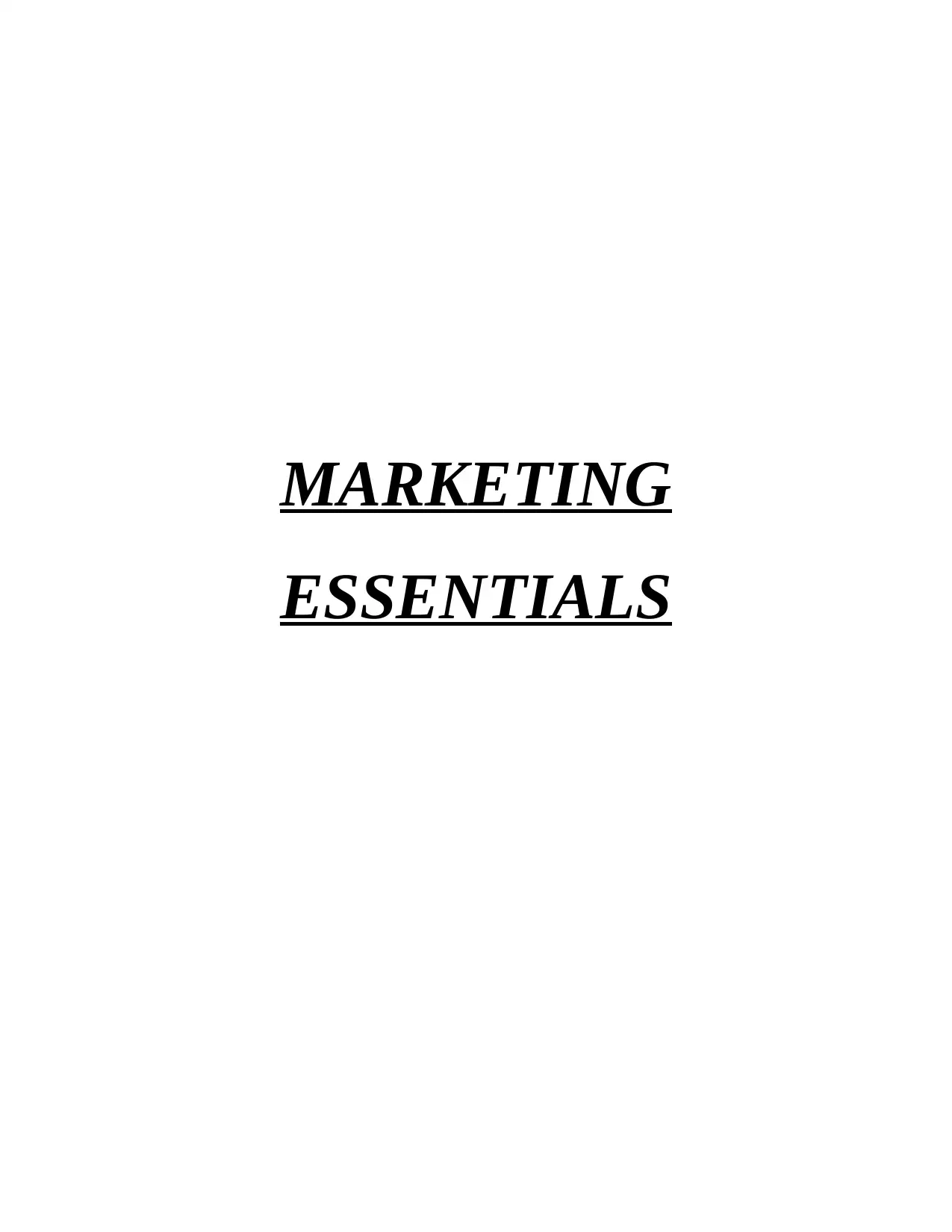
MARKETING
ESSENTIALS
ESSENTIALS
Secure Best Marks with AI Grader
Need help grading? Try our AI Grader for instant feedback on your assignments.
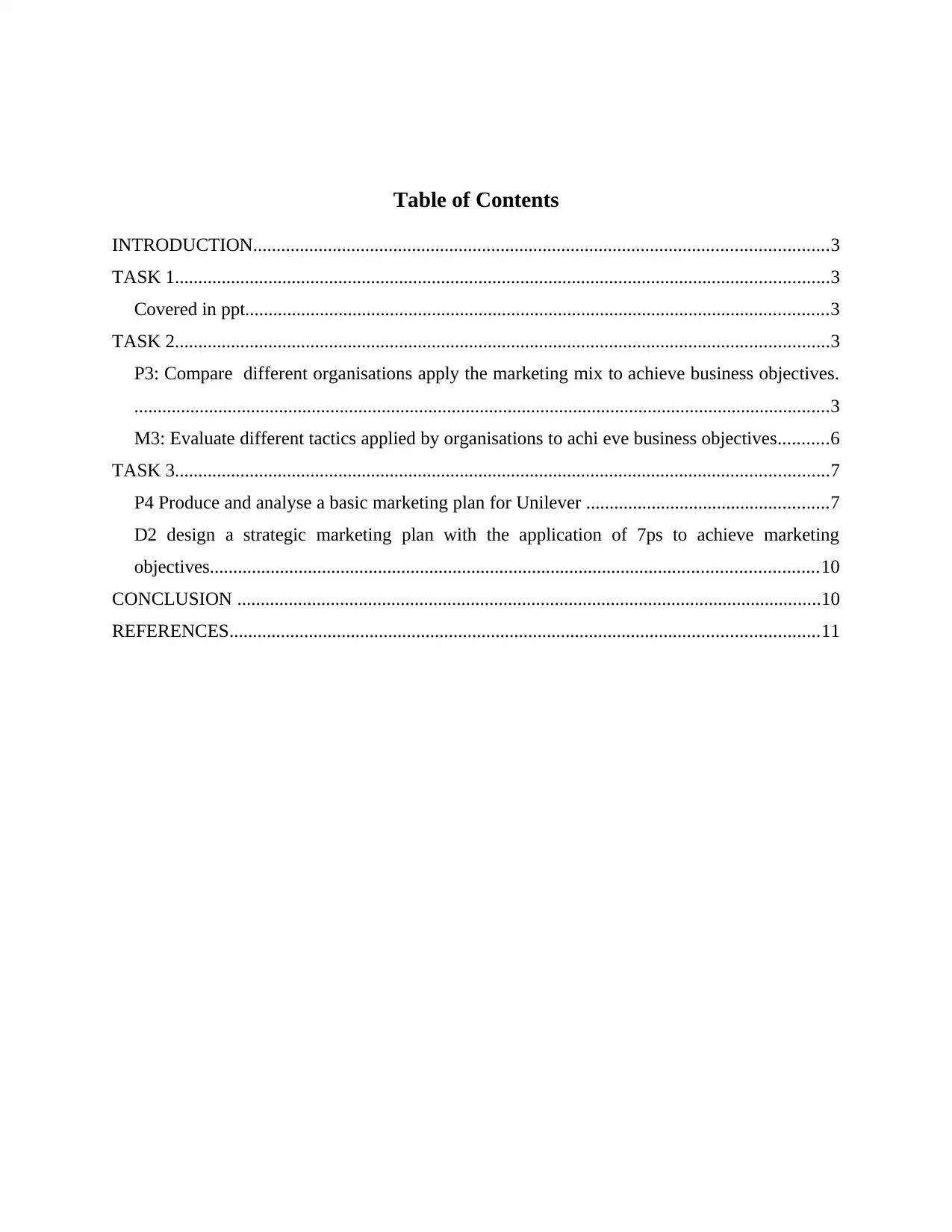
Table of Contents
INTRODUCTION...........................................................................................................................3
TASK 1............................................................................................................................................3
Covered in ppt.............................................................................................................................3
TASK 2............................................................................................................................................3
P3: Compare different organisations apply the marketing mix to achieve business objectives.
.....................................................................................................................................................3
M3: Evaluate different tactics applied by organisations to achi eve business objectives...........6
TASK 3............................................................................................................................................7
P4 Produce and analyse a basic marketing plan for Unilever ....................................................7
D2 design a strategic marketing plan with the application of 7ps to achieve marketing
objectives..................................................................................................................................10
CONCLUSION .............................................................................................................................10
REFERENCES..............................................................................................................................11
INTRODUCTION...........................................................................................................................3
TASK 1............................................................................................................................................3
Covered in ppt.............................................................................................................................3
TASK 2............................................................................................................................................3
P3: Compare different organisations apply the marketing mix to achieve business objectives.
.....................................................................................................................................................3
M3: Evaluate different tactics applied by organisations to achi eve business objectives...........6
TASK 3............................................................................................................................................7
P4 Produce and analyse a basic marketing plan for Unilever ....................................................7
D2 design a strategic marketing plan with the application of 7ps to achieve marketing
objectives..................................................................................................................................10
CONCLUSION .............................................................................................................................10
REFERENCES..............................................................................................................................11
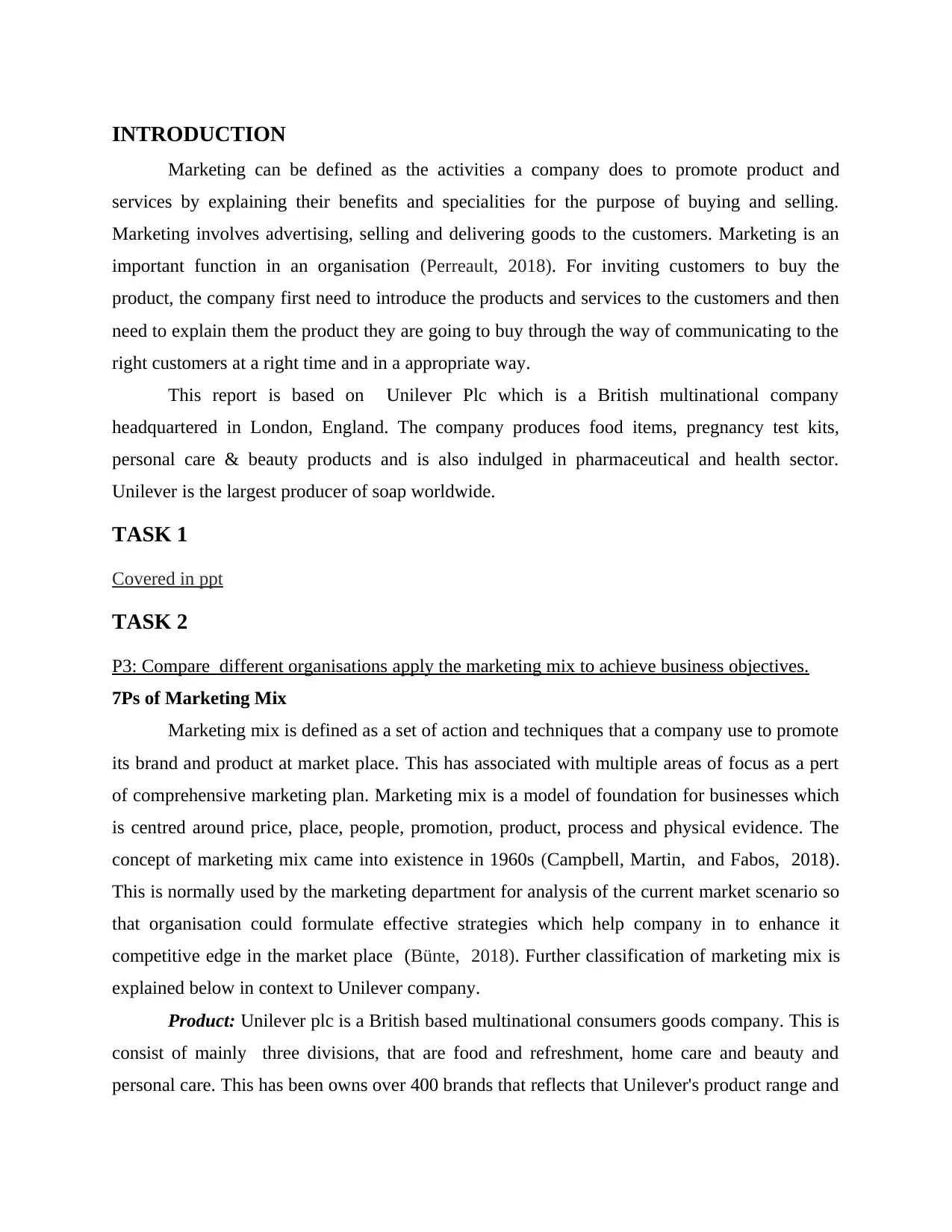
INTRODUCTION
Marketing can be defined as the activities a company does to promote product and
services by explaining their benefits and specialities for the purpose of buying and selling.
Marketing involves advertising, selling and delivering goods to the customers. Marketing is an
important function in an organisation (Perreault, 2018). For inviting customers to buy the
product, the company first need to introduce the products and services to the customers and then
need to explain them the product they are going to buy through the way of communicating to the
right customers at a right time and in a appropriate way.
This report is based on Unilever Plc which is a British multinational company
headquartered in London, England. The company produces food items, pregnancy test kits,
personal care & beauty products and is also indulged in pharmaceutical and health sector.
Unilever is the largest producer of soap worldwide.
TASK 1
Covered in ppt
TASK 2
P3: Compare different organisations apply the marketing mix to achieve business objectives.
7Ps of Marketing Mix
Marketing mix is defined as a set of action and techniques that a company use to promote
its brand and product at market place. This has associated with multiple areas of focus as a pert
of comprehensive marketing plan. Marketing mix is a model of foundation for businesses which
is centred around price, place, people, promotion, product, process and physical evidence. The
concept of marketing mix came into existence in 1960s (Campbell, Martin, and Fabos, 2018).
This is normally used by the marketing department for analysis of the current market scenario so
that organisation could formulate effective strategies which help company in to enhance it
competitive edge in the market place (Bünte, 2018). Further classification of marketing mix is
explained below in context to Unilever company.
Product: Unilever plc is a British based multinational consumers goods company. This is
consist of mainly three divisions, that are food and refreshment, home care and beauty and
personal care. This has been owns over 400 brands that reflects that Unilever's product range and
Marketing can be defined as the activities a company does to promote product and
services by explaining their benefits and specialities for the purpose of buying and selling.
Marketing involves advertising, selling and delivering goods to the customers. Marketing is an
important function in an organisation (Perreault, 2018). For inviting customers to buy the
product, the company first need to introduce the products and services to the customers and then
need to explain them the product they are going to buy through the way of communicating to the
right customers at a right time and in a appropriate way.
This report is based on Unilever Plc which is a British multinational company
headquartered in London, England. The company produces food items, pregnancy test kits,
personal care & beauty products and is also indulged in pharmaceutical and health sector.
Unilever is the largest producer of soap worldwide.
TASK 1
Covered in ppt
TASK 2
P3: Compare different organisations apply the marketing mix to achieve business objectives.
7Ps of Marketing Mix
Marketing mix is defined as a set of action and techniques that a company use to promote
its brand and product at market place. This has associated with multiple areas of focus as a pert
of comprehensive marketing plan. Marketing mix is a model of foundation for businesses which
is centred around price, place, people, promotion, product, process and physical evidence. The
concept of marketing mix came into existence in 1960s (Campbell, Martin, and Fabos, 2018).
This is normally used by the marketing department for analysis of the current market scenario so
that organisation could formulate effective strategies which help company in to enhance it
competitive edge in the market place (Bünte, 2018). Further classification of marketing mix is
explained below in context to Unilever company.
Product: Unilever plc is a British based multinational consumers goods company. This is
consist of mainly three divisions, that are food and refreshment, home care and beauty and
personal care. This has been owns over 400 brands that reflects that Unilever's product range and
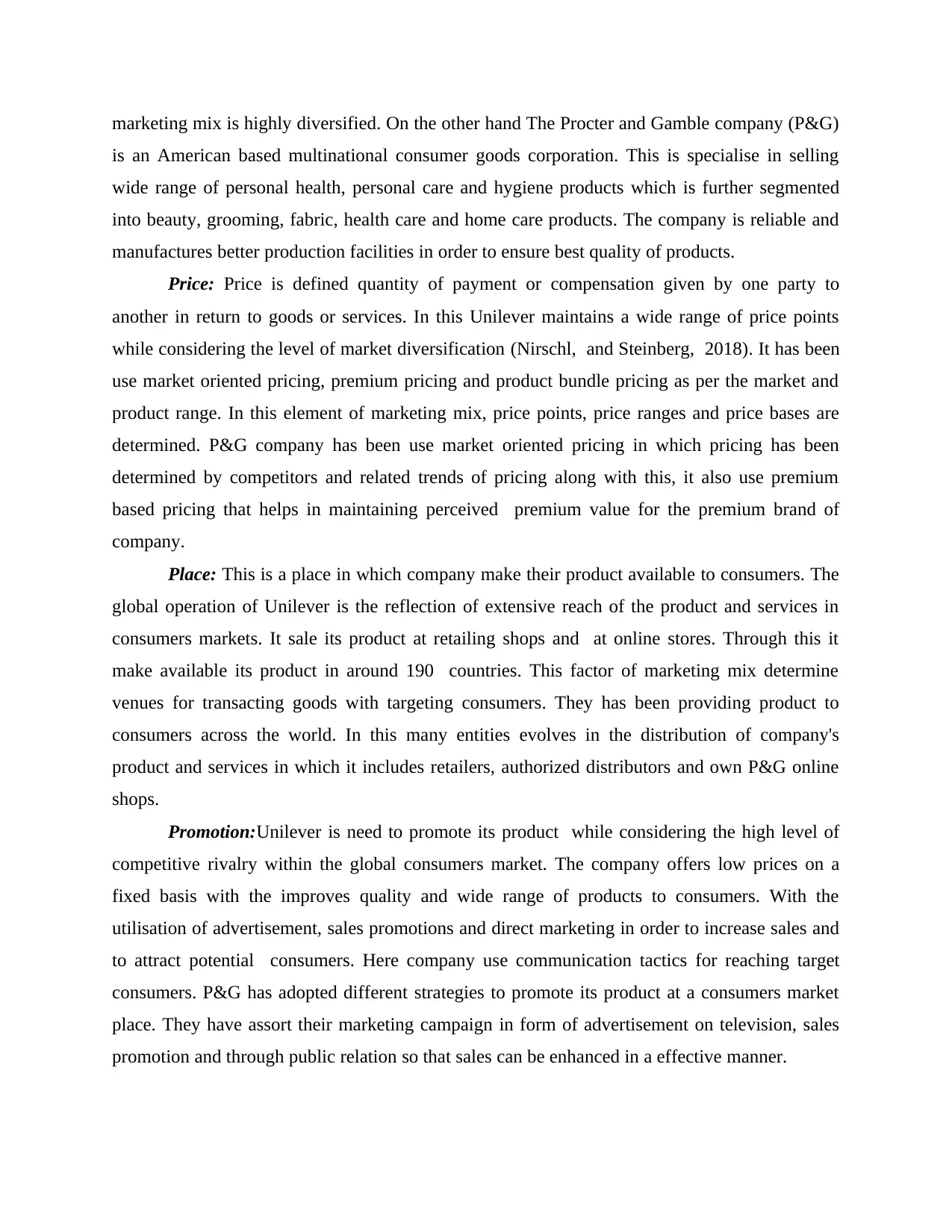
marketing mix is highly diversified. On the other hand The Procter and Gamble company (P&G)
is an American based multinational consumer goods corporation. This is specialise in selling
wide range of personal health, personal care and hygiene products which is further segmented
into beauty, grooming, fabric, health care and home care products. The company is reliable and
manufactures better production facilities in order to ensure best quality of products.
Price: Price is defined quantity of payment or compensation given by one party to
another in return to goods or services. In this Unilever maintains a wide range of price points
while considering the level of market diversification (Nirschl, and Steinberg, 2018). It has been
use market oriented pricing, premium pricing and product bundle pricing as per the market and
product range. In this element of marketing mix, price points, price ranges and price bases are
determined. P&G company has been use market oriented pricing in which pricing has been
determined by competitors and related trends of pricing along with this, it also use premium
based pricing that helps in maintaining perceived premium value for the premium brand of
company.
Place: This is a place in which company make their product available to consumers. The
global operation of Unilever is the reflection of extensive reach of the product and services in
consumers markets. It sale its product at retailing shops and at online stores. Through this it
make available its product in around 190 countries. This factor of marketing mix determine
venues for transacting goods with targeting consumers. They has been providing product to
consumers across the world. In this many entities evolves in the distribution of company's
product and services in which it includes retailers, authorized distributors and own P&G online
shops.
Promotion:Unilever is need to promote its product while considering the high level of
competitive rivalry within the global consumers market. The company offers low prices on a
fixed basis with the improves quality and wide range of products to consumers. With the
utilisation of advertisement, sales promotions and direct marketing in order to increase sales and
to attract potential consumers. Here company use communication tactics for reaching target
consumers. P&G has adopted different strategies to promote its product at a consumers market
place. They have assort their marketing campaign in form of advertisement on television, sales
promotion and through public relation so that sales can be enhanced in a effective manner.
is an American based multinational consumer goods corporation. This is specialise in selling
wide range of personal health, personal care and hygiene products which is further segmented
into beauty, grooming, fabric, health care and home care products. The company is reliable and
manufactures better production facilities in order to ensure best quality of products.
Price: Price is defined quantity of payment or compensation given by one party to
another in return to goods or services. In this Unilever maintains a wide range of price points
while considering the level of market diversification (Nirschl, and Steinberg, 2018). It has been
use market oriented pricing, premium pricing and product bundle pricing as per the market and
product range. In this element of marketing mix, price points, price ranges and price bases are
determined. P&G company has been use market oriented pricing in which pricing has been
determined by competitors and related trends of pricing along with this, it also use premium
based pricing that helps in maintaining perceived premium value for the premium brand of
company.
Place: This is a place in which company make their product available to consumers. The
global operation of Unilever is the reflection of extensive reach of the product and services in
consumers markets. It sale its product at retailing shops and at online stores. Through this it
make available its product in around 190 countries. This factor of marketing mix determine
venues for transacting goods with targeting consumers. They has been providing product to
consumers across the world. In this many entities evolves in the distribution of company's
product and services in which it includes retailers, authorized distributors and own P&G online
shops.
Promotion:Unilever is need to promote its product while considering the high level of
competitive rivalry within the global consumers market. The company offers low prices on a
fixed basis with the improves quality and wide range of products to consumers. With the
utilisation of advertisement, sales promotions and direct marketing in order to increase sales and
to attract potential consumers. Here company use communication tactics for reaching target
consumers. P&G has adopted different strategies to promote its product at a consumers market
place. They have assort their marketing campaign in form of advertisement on television, sales
promotion and through public relation so that sales can be enhanced in a effective manner.
Secure Best Marks with AI Grader
Need help grading? Try our AI Grader for instant feedback on your assignments.
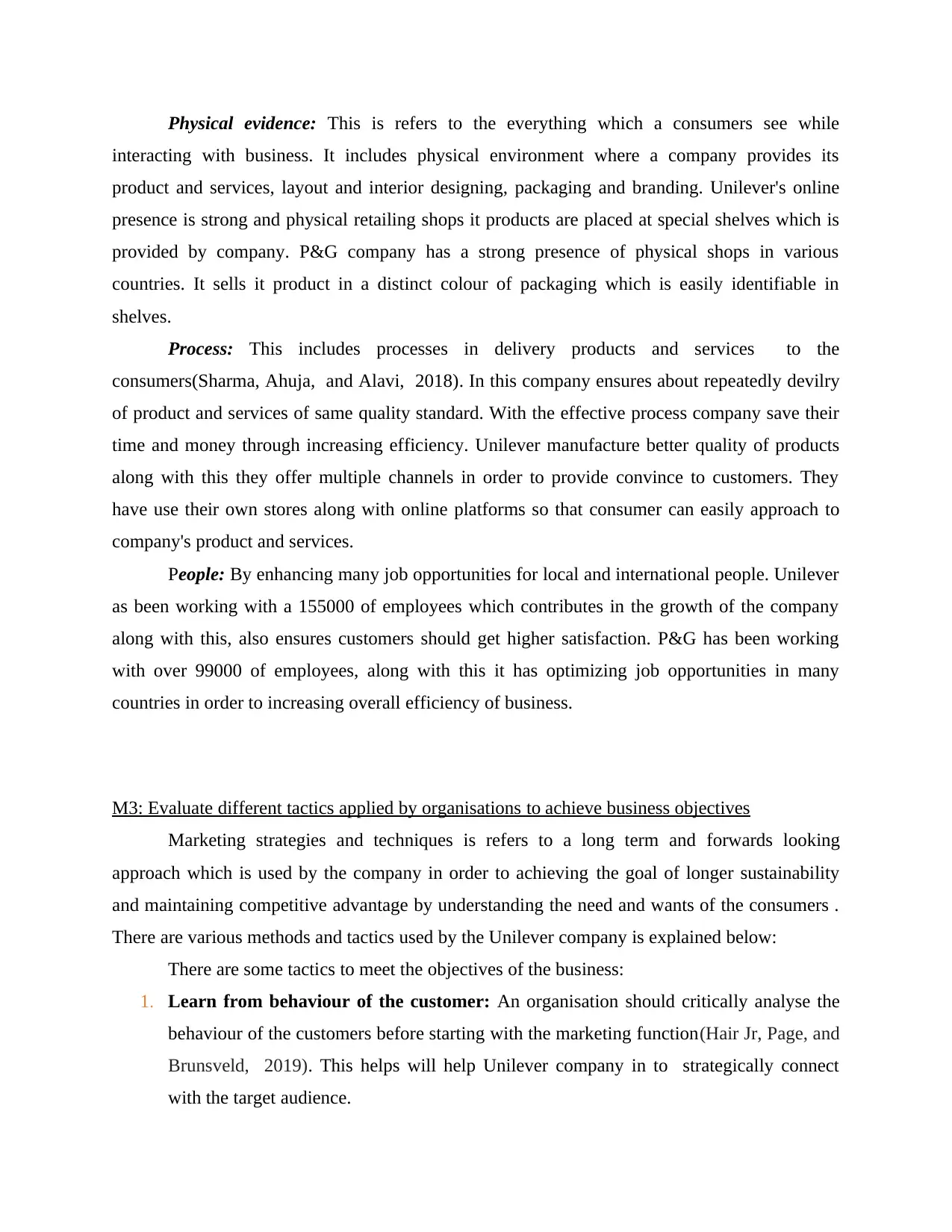
Physical evidence: This is refers to the everything which a consumers see while
interacting with business. It includes physical environment where a company provides its
product and services, layout and interior designing, packaging and branding. Unilever's online
presence is strong and physical retailing shops it products are placed at special shelves which is
provided by company. P&G company has a strong presence of physical shops in various
countries. It sells it product in a distinct colour of packaging which is easily identifiable in
shelves.
Process: This includes processes in delivery products and services to the
consumers(Sharma, Ahuja, and Alavi, 2018). In this company ensures about repeatedly devilry
of product and services of same quality standard. With the effective process company save their
time and money through increasing efficiency. Unilever manufacture better quality of products
along with this they offer multiple channels in order to provide convince to customers. They
have use their own stores along with online platforms so that consumer can easily approach to
company's product and services.
People: By enhancing many job opportunities for local and international people. Unilever
as been working with a 155000 of employees which contributes in the growth of the company
along with this, also ensures customers should get higher satisfaction. P&G has been working
with over 99000 of employees, along with this it has optimizing job opportunities in many
countries in order to increasing overall efficiency of business.
M3: Evaluate different tactics applied by organisations to achieve business objectives
Marketing strategies and techniques is refers to a long term and forwards looking
approach which is used by the company in order to achieving the goal of longer sustainability
and maintaining competitive advantage by understanding the need and wants of the consumers .
There are various methods and tactics used by the Unilever company is explained below:
There are some tactics to meet the objectives of the business:
1. Learn from behaviour of the customer: An organisation should critically analyse the
behaviour of the customers before starting with the marketing function(Hair Jr, Page, and
Brunsveld, 2019). This helps will help Unilever company in to strategically connect
with the target audience.
interacting with business. It includes physical environment where a company provides its
product and services, layout and interior designing, packaging and branding. Unilever's online
presence is strong and physical retailing shops it products are placed at special shelves which is
provided by company. P&G company has a strong presence of physical shops in various
countries. It sells it product in a distinct colour of packaging which is easily identifiable in
shelves.
Process: This includes processes in delivery products and services to the
consumers(Sharma, Ahuja, and Alavi, 2018). In this company ensures about repeatedly devilry
of product and services of same quality standard. With the effective process company save their
time and money through increasing efficiency. Unilever manufacture better quality of products
along with this they offer multiple channels in order to provide convince to customers. They
have use their own stores along with online platforms so that consumer can easily approach to
company's product and services.
People: By enhancing many job opportunities for local and international people. Unilever
as been working with a 155000 of employees which contributes in the growth of the company
along with this, also ensures customers should get higher satisfaction. P&G has been working
with over 99000 of employees, along with this it has optimizing job opportunities in many
countries in order to increasing overall efficiency of business.
M3: Evaluate different tactics applied by organisations to achieve business objectives
Marketing strategies and techniques is refers to a long term and forwards looking
approach which is used by the company in order to achieving the goal of longer sustainability
and maintaining competitive advantage by understanding the need and wants of the consumers .
There are various methods and tactics used by the Unilever company is explained below:
There are some tactics to meet the objectives of the business:
1. Learn from behaviour of the customer: An organisation should critically analyse the
behaviour of the customers before starting with the marketing function(Hair Jr, Page, and
Brunsveld, 2019). This helps will help Unilever company in to strategically connect
with the target audience.
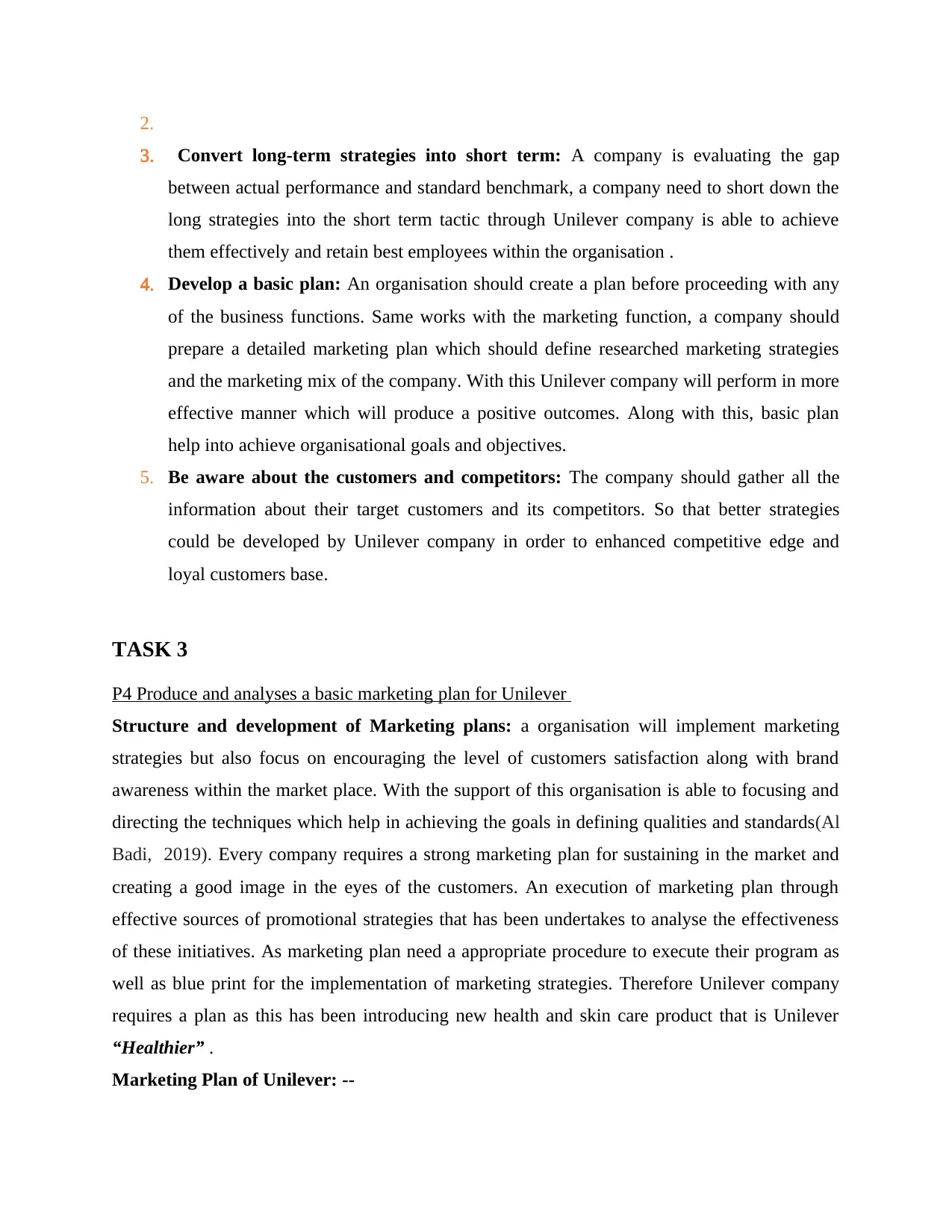
2.
3. Convert long-term strategies into short term: A company is evaluating the gap
between actual performance and standard benchmark, a company need to short down the
long strategies into the short term tactic through Unilever company is able to achieve
them effectively and retain best employees within the organisation .
4. Develop a basic plan: An organisation should create a plan before proceeding with any
of the business functions. Same works with the marketing function, a company should
prepare a detailed marketing plan which should define researched marketing strategies
and the marketing mix of the company. With this Unilever company will perform in more
effective manner which will produce a positive outcomes. Along with this, basic plan
help into achieve organisational goals and objectives.
5. Be aware about the customers and competitors: The company should gather all the
information about their target customers and its competitors. So that better strategies
could be developed by Unilever company in order to enhanced competitive edge and
loyal customers base.
TASK 3
P4 Produce and analyses a basic marketing plan for Unilever
Structure and development of Marketing plans: a organisation will implement marketing
strategies but also focus on encouraging the level of customers satisfaction along with brand
awareness within the market place. With the support of this organisation is able to focusing and
directing the techniques which help in achieving the goals in defining qualities and standards(Al
Badi, 2019). Every company requires a strong marketing plan for sustaining in the market and
creating a good image in the eyes of the customers. An execution of marketing plan through
effective sources of promotional strategies that has been undertakes to analyse the effectiveness
of these initiatives. As marketing plan need a appropriate procedure to execute their program as
well as blue print for the implementation of marketing strategies. Therefore Unilever company
requires a plan as this has been introducing new health and skin care product that is Unilever
“Healthier” .
Marketing Plan of Unilever: --
3. Convert long-term strategies into short term: A company is evaluating the gap
between actual performance and standard benchmark, a company need to short down the
long strategies into the short term tactic through Unilever company is able to achieve
them effectively and retain best employees within the organisation .
4. Develop a basic plan: An organisation should create a plan before proceeding with any
of the business functions. Same works with the marketing function, a company should
prepare a detailed marketing plan which should define researched marketing strategies
and the marketing mix of the company. With this Unilever company will perform in more
effective manner which will produce a positive outcomes. Along with this, basic plan
help into achieve organisational goals and objectives.
5. Be aware about the customers and competitors: The company should gather all the
information about their target customers and its competitors. So that better strategies
could be developed by Unilever company in order to enhanced competitive edge and
loyal customers base.
TASK 3
P4 Produce and analyses a basic marketing plan for Unilever
Structure and development of Marketing plans: a organisation will implement marketing
strategies but also focus on encouraging the level of customers satisfaction along with brand
awareness within the market place. With the support of this organisation is able to focusing and
directing the techniques which help in achieving the goals in defining qualities and standards(Al
Badi, 2019). Every company requires a strong marketing plan for sustaining in the market and
creating a good image in the eyes of the customers. An execution of marketing plan through
effective sources of promotional strategies that has been undertakes to analyse the effectiveness
of these initiatives. As marketing plan need a appropriate procedure to execute their program as
well as blue print for the implementation of marketing strategies. Therefore Unilever company
requires a plan as this has been introducing new health and skin care product that is Unilever
“Healthier” .
Marketing Plan of Unilever: --
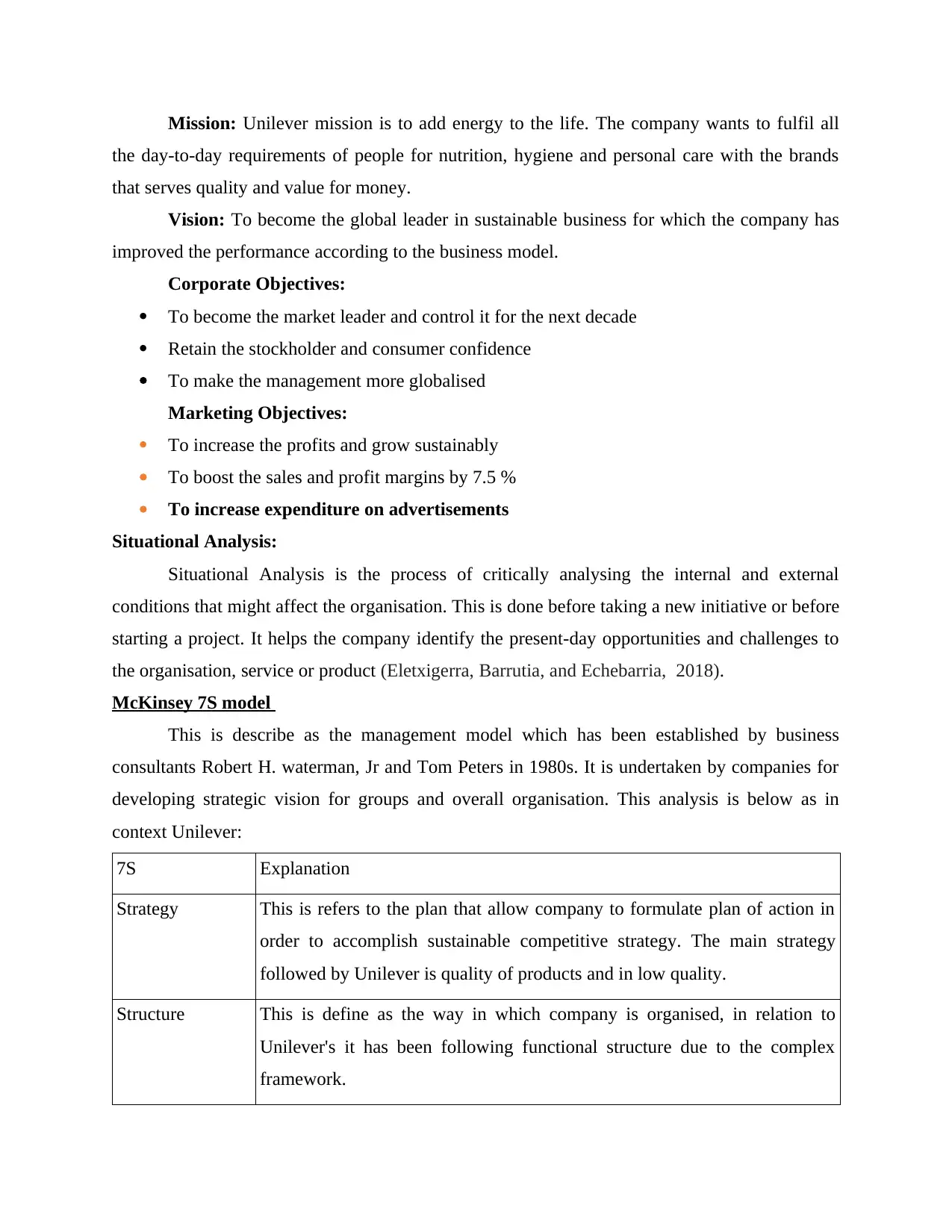
Mission: Unilever mission is to add energy to the life. The company wants to fulfil all
the day-to-day requirements of people for nutrition, hygiene and personal care with the brands
that serves quality and value for money.
Vision: To become the global leader in sustainable business for which the company has
improved the performance according to the business model.
Corporate Objectives:
To become the market leader and control it for the next decade
Retain the stockholder and consumer confidence
To make the management more globalised
Marketing Objectives:
To increase the profits and grow sustainably
To boost the sales and profit margins by 7.5 %
To increase expenditure on advertisements
Situational Analysis:
Situational Analysis is the process of critically analysing the internal and external
conditions that might affect the organisation. This is done before taking a new initiative or before
starting a project. It helps the company identify the present-day opportunities and challenges to
the organisation, service or product (Eletxigerra, Barrutia, and Echebarria, 2018).
McKinsey 7S model
This is describe as the management model which has been established by business
consultants Robert H. waterman, Jr and Tom Peters in 1980s. It is undertaken by companies for
developing strategic vision for groups and overall organisation. This analysis is below as in
context Unilever:
7S Explanation
Strategy This is refers to the plan that allow company to formulate plan of action in
order to accomplish sustainable competitive strategy. The main strategy
followed by Unilever is quality of products and in low quality.
Structure This is define as the way in which company is organised, in relation to
Unilever's it has been following functional structure due to the complex
framework.
the day-to-day requirements of people for nutrition, hygiene and personal care with the brands
that serves quality and value for money.
Vision: To become the global leader in sustainable business for which the company has
improved the performance according to the business model.
Corporate Objectives:
To become the market leader and control it for the next decade
Retain the stockholder and consumer confidence
To make the management more globalised
Marketing Objectives:
To increase the profits and grow sustainably
To boost the sales and profit margins by 7.5 %
To increase expenditure on advertisements
Situational Analysis:
Situational Analysis is the process of critically analysing the internal and external
conditions that might affect the organisation. This is done before taking a new initiative or before
starting a project. It helps the company identify the present-day opportunities and challenges to
the organisation, service or product (Eletxigerra, Barrutia, and Echebarria, 2018).
McKinsey 7S model
This is describe as the management model which has been established by business
consultants Robert H. waterman, Jr and Tom Peters in 1980s. It is undertaken by companies for
developing strategic vision for groups and overall organisation. This analysis is below as in
context Unilever:
7S Explanation
Strategy This is refers to the plan that allow company to formulate plan of action in
order to accomplish sustainable competitive strategy. The main strategy
followed by Unilever is quality of products and in low quality.
Structure This is define as the way in which company is organised, in relation to
Unilever's it has been following functional structure due to the complex
framework.
Paraphrase This Document
Need a fresh take? Get an instant paraphrase of this document with our AI Paraphraser
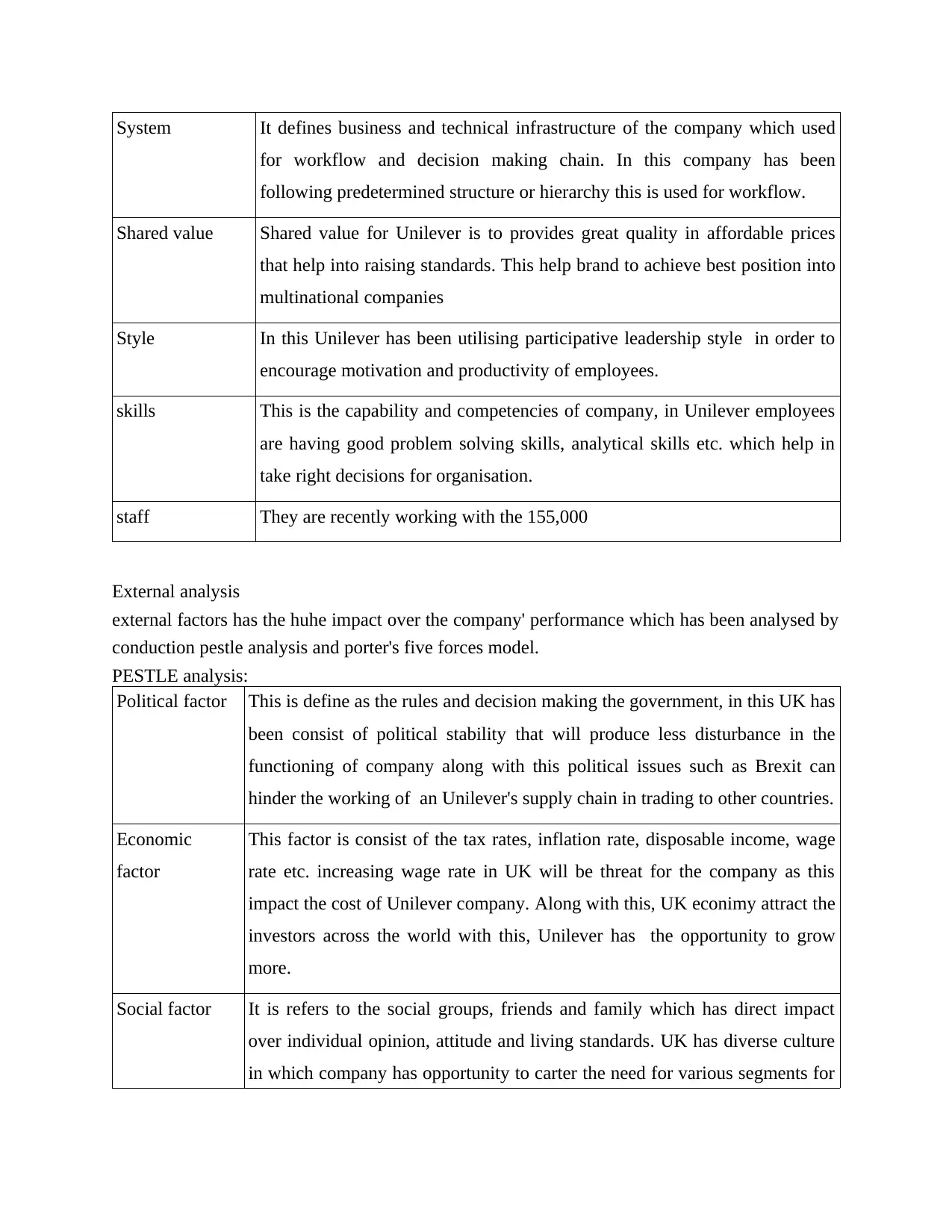
System It defines business and technical infrastructure of the company which used
for workflow and decision making chain. In this company has been
following predetermined structure or hierarchy this is used for workflow.
Shared value Shared value for Unilever is to provides great quality in affordable prices
that help into raising standards. This help brand to achieve best position into
multinational companies
Style In this Unilever has been utilising participative leadership style in order to
encourage motivation and productivity of employees.
skills This is the capability and competencies of company, in Unilever employees
are having good problem solving skills, analytical skills etc. which help in
take right decisions for organisation.
staff They are recently working with the 155,000
External analysis
external factors has the huhe impact over the company' performance which has been analysed by
conduction pestle analysis and porter's five forces model.
PESTLE analysis:
Political factor This is define as the rules and decision making the government, in this UK has
been consist of political stability that will produce less disturbance in the
functioning of company along with this political issues such as Brexit can
hinder the working of an Unilever's supply chain in trading to other countries.
Economic
factor
This factor is consist of the tax rates, inflation rate, disposable income, wage
rate etc. increasing wage rate in UK will be threat for the company as this
impact the cost of Unilever company. Along with this, UK econimy attract the
investors across the world with this, Unilever has the opportunity to grow
more.
Social factor It is refers to the social groups, friends and family which has direct impact
over individual opinion, attitude and living standards. UK has diverse culture
in which company has opportunity to carter the need for various segments for
for workflow and decision making chain. In this company has been
following predetermined structure or hierarchy this is used for workflow.
Shared value Shared value for Unilever is to provides great quality in affordable prices
that help into raising standards. This help brand to achieve best position into
multinational companies
Style In this Unilever has been utilising participative leadership style in order to
encourage motivation and productivity of employees.
skills This is the capability and competencies of company, in Unilever employees
are having good problem solving skills, analytical skills etc. which help in
take right decisions for organisation.
staff They are recently working with the 155,000
External analysis
external factors has the huhe impact over the company' performance which has been analysed by
conduction pestle analysis and porter's five forces model.
PESTLE analysis:
Political factor This is define as the rules and decision making the government, in this UK has
been consist of political stability that will produce less disturbance in the
functioning of company along with this political issues such as Brexit can
hinder the working of an Unilever's supply chain in trading to other countries.
Economic
factor
This factor is consist of the tax rates, inflation rate, disposable income, wage
rate etc. increasing wage rate in UK will be threat for the company as this
impact the cost of Unilever company. Along with this, UK econimy attract the
investors across the world with this, Unilever has the opportunity to grow
more.
Social factor It is refers to the social groups, friends and family which has direct impact
over individual opinion, attitude and living standards. UK has diverse culture
in which company has opportunity to carter the need for various segments for
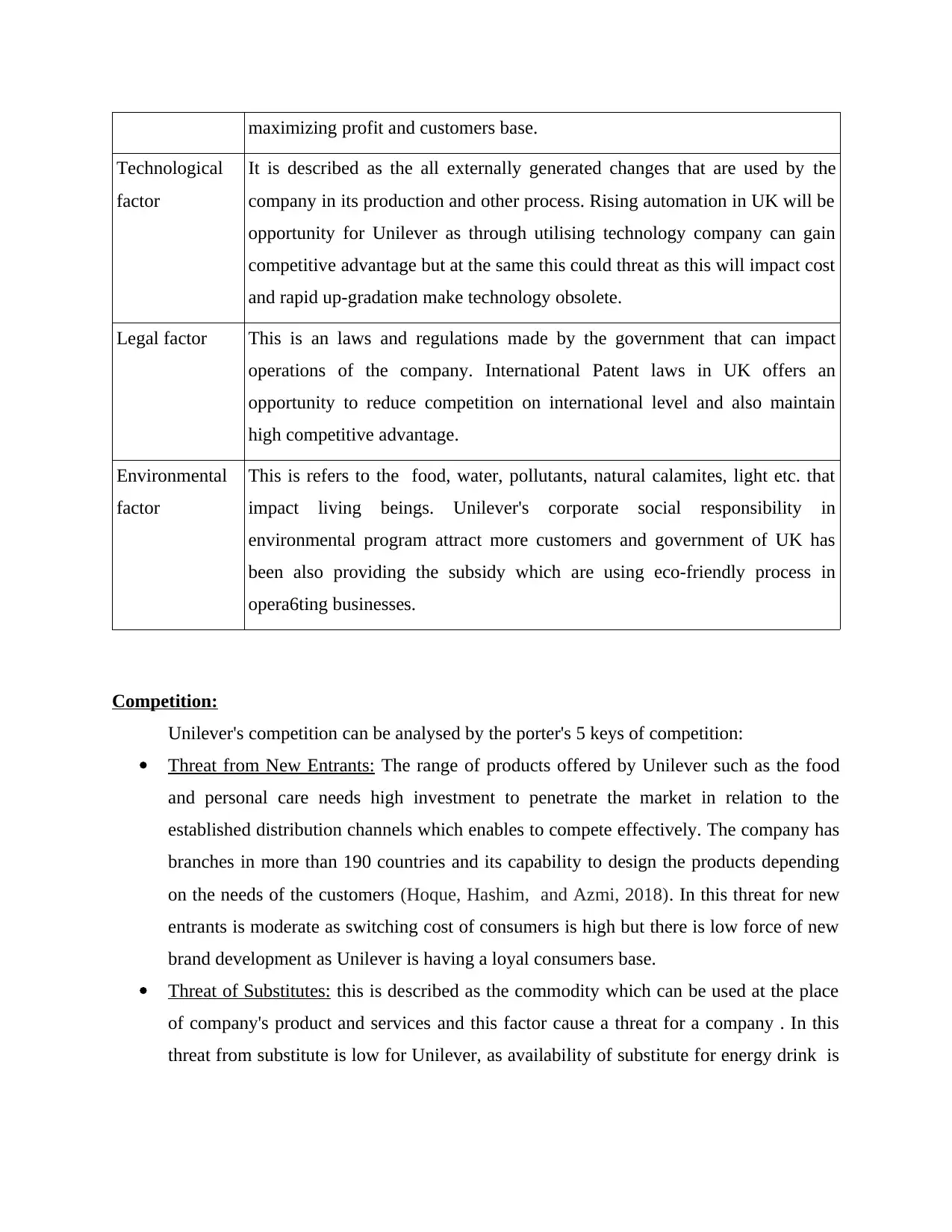
maximizing profit and customers base.
Technological
factor
It is described as the all externally generated changes that are used by the
company in its production and other process. Rising automation in UK will be
opportunity for Unilever as through utilising technology company can gain
competitive advantage but at the same this could threat as this will impact cost
and rapid up-gradation make technology obsolete.
Legal factor This is an laws and regulations made by the government that can impact
operations of the company. International Patent laws in UK offers an
opportunity to reduce competition on international level and also maintain
high competitive advantage.
Environmental
factor
This is refers to the food, water, pollutants, natural calamites, light etc. that
impact living beings. Unilever's corporate social responsibility in
environmental program attract more customers and government of UK has
been also providing the subsidy which are using eco-friendly process in
opera6ting businesses.
Competition:
Unilever's competition can be analysed by the porter's 5 keys of competition:
Threat from New Entrants: The range of products offered by Unilever such as the food
and personal care needs high investment to penetrate the market in relation to the
established distribution channels which enables to compete effectively. The company has
branches in more than 190 countries and its capability to design the products depending
on the needs of the customers (Hoque, Hashim, and Azmi, 2018). In this threat for new
entrants is moderate as switching cost of consumers is high but there is low force of new
brand development as Unilever is having a loyal consumers base.
Threat of Substitutes: this is described as the commodity which can be used at the place
of company's product and services and this factor cause a threat for a company . In this
threat from substitute is low for Unilever, as availability of substitute for energy drink is
Technological
factor
It is described as the all externally generated changes that are used by the
company in its production and other process. Rising automation in UK will be
opportunity for Unilever as through utilising technology company can gain
competitive advantage but at the same this could threat as this will impact cost
and rapid up-gradation make technology obsolete.
Legal factor This is an laws and regulations made by the government that can impact
operations of the company. International Patent laws in UK offers an
opportunity to reduce competition on international level and also maintain
high competitive advantage.
Environmental
factor
This is refers to the food, water, pollutants, natural calamites, light etc. that
impact living beings. Unilever's corporate social responsibility in
environmental program attract more customers and government of UK has
been also providing the subsidy which are using eco-friendly process in
opera6ting businesses.
Competition:
Unilever's competition can be analysed by the porter's 5 keys of competition:
Threat from New Entrants: The range of products offered by Unilever such as the food
and personal care needs high investment to penetrate the market in relation to the
established distribution channels which enables to compete effectively. The company has
branches in more than 190 countries and its capability to design the products depending
on the needs of the customers (Hoque, Hashim, and Azmi, 2018). In this threat for new
entrants is moderate as switching cost of consumers is high but there is low force of new
brand development as Unilever is having a loyal consumers base.
Threat of Substitutes: this is described as the commodity which can be used at the place
of company's product and services and this factor cause a threat for a company . In this
threat from substitute is low for Unilever, as availability of substitute for energy drink is

low but along with switching cost is high as there many brands are already available in
market.
Bargaining power of customers: it is defined as the customers power which can drive a
prices lower. This is effected by the loyal consumers base that a company has and how
much it cost in finding new consumers. In this bargaining power of consumers is high as
there are many competitors in industry that are selling same type of products and services
to consumers. Here switching cost for Unilever is high along with this, consumers having
high quality of information about companies offering.
Bargaining Powers of suppliers : This factor of model addressed that how easily suppliers
can drive the prices higher for key inputs (Baack, Czarnecka, and Baack, 2018) . This
get effected by the number of suppliers of key raw materials of goods and services and
how unique these raw materials are. Here bargaining power of suppliers is moderate, as
there are many suppliers of inputs within retailing but brand like Unilever is having there
fix suppliers for the inputs through which they maintain the adequate quality of products.
Competitive rivalry: this factor is defined as the number of competitors within the
industry and their power to undercut a competitive firm. Suppliers and buyers look
towards the company's competition in order to get a better deal and lower prices. In this
competitive rivalry is high as there many brands that are selling homogeneous products
such as P&G, NESTLE, Kimberly-Clark etc. there is a high aggressiveness in
competition among the firms and customers can switch easily to another brand this has a
direct impact over the company's performance and productivity.
SWOT Analysis of Unilever:
Strengths: Unilever currently functions in somewhat around 190 countries around the
world. It works in diversified range of products and brands which differentiates it from
the other in the market which helps the company to cope up with the dynamic preferences
of the consumers.
Weaknesses: The main weakness of Unilever is that it functions in an competitive market
where there is a competition like Proctor & Gamble and Nestle. This competition
challenges the company at every time due to there are lot of changes in the price of the
product and services(Avila-Robinson, and Wakabayashi, 2018). The other weakness of
market.
Bargaining power of customers: it is defined as the customers power which can drive a
prices lower. This is effected by the loyal consumers base that a company has and how
much it cost in finding new consumers. In this bargaining power of consumers is high as
there are many competitors in industry that are selling same type of products and services
to consumers. Here switching cost for Unilever is high along with this, consumers having
high quality of information about companies offering.
Bargaining Powers of suppliers : This factor of model addressed that how easily suppliers
can drive the prices higher for key inputs (Baack, Czarnecka, and Baack, 2018) . This
get effected by the number of suppliers of key raw materials of goods and services and
how unique these raw materials are. Here bargaining power of suppliers is moderate, as
there are many suppliers of inputs within retailing but brand like Unilever is having there
fix suppliers for the inputs through which they maintain the adequate quality of products.
Competitive rivalry: this factor is defined as the number of competitors within the
industry and their power to undercut a competitive firm. Suppliers and buyers look
towards the company's competition in order to get a better deal and lower prices. In this
competitive rivalry is high as there many brands that are selling homogeneous products
such as P&G, NESTLE, Kimberly-Clark etc. there is a high aggressiveness in
competition among the firms and customers can switch easily to another brand this has a
direct impact over the company's performance and productivity.
SWOT Analysis of Unilever:
Strengths: Unilever currently functions in somewhat around 190 countries around the
world. It works in diversified range of products and brands which differentiates it from
the other in the market which helps the company to cope up with the dynamic preferences
of the consumers.
Weaknesses: The main weakness of Unilever is that it functions in an competitive market
where there is a competition like Proctor & Gamble and Nestle. This competition
challenges the company at every time due to there are lot of changes in the price of the
product and services(Avila-Robinson, and Wakabayashi, 2018). The other weakness of
Secure Best Marks with AI Grader
Need help grading? Try our AI Grader for instant feedback on your assignments.
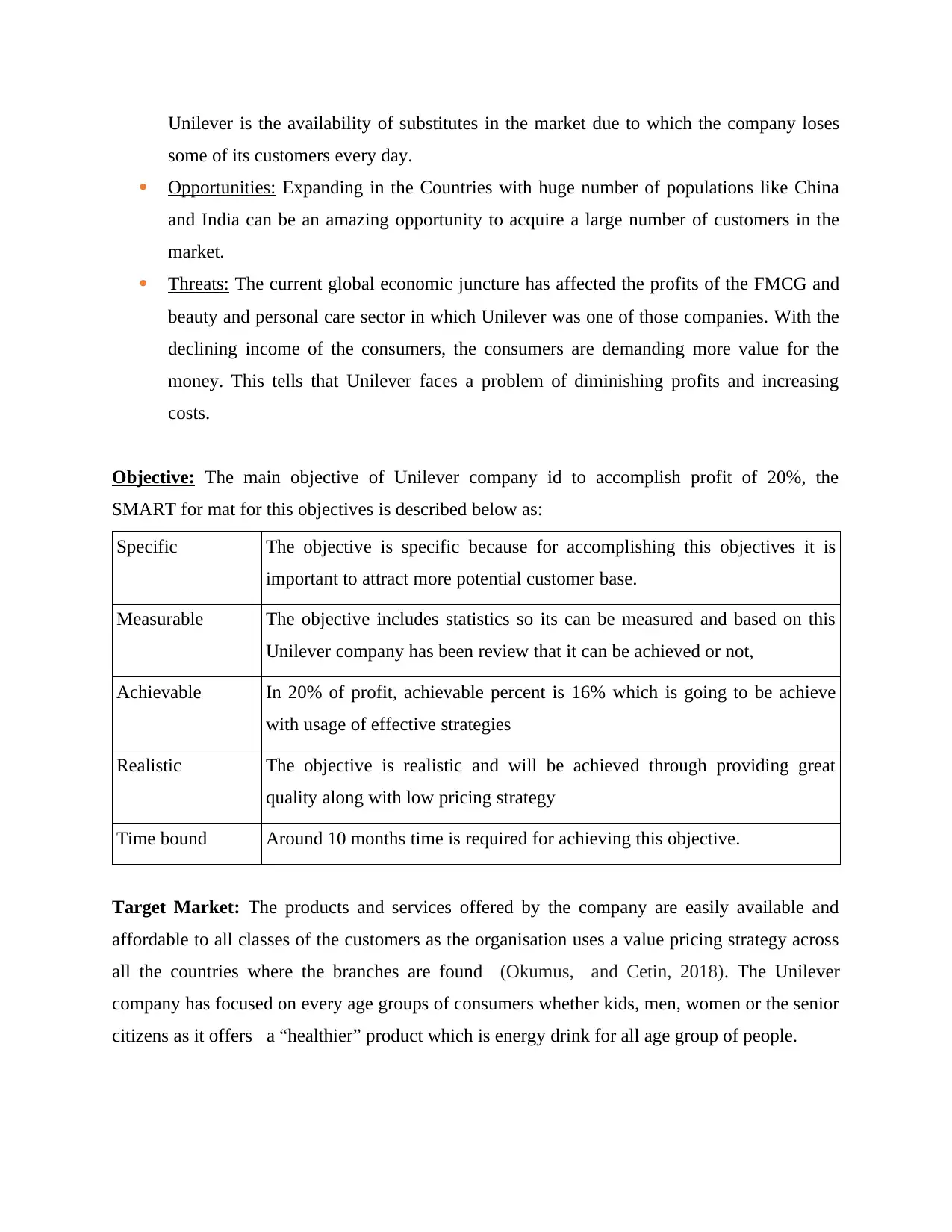
Unilever is the availability of substitutes in the market due to which the company loses
some of its customers every day.
Opportunities: Expanding in the Countries with huge number of populations like China
and India can be an amazing opportunity to acquire a large number of customers in the
market.
Threats: The current global economic juncture has affected the profits of the FMCG and
beauty and personal care sector in which Unilever was one of those companies. With the
declining income of the consumers, the consumers are demanding more value for the
money. This tells that Unilever faces a problem of diminishing profits and increasing
costs.
Objective: The main objective of Unilever company id to accomplish profit of 20%, the
SMART for mat for this objectives is described below as:
Specific The objective is specific because for accomplishing this objectives it is
important to attract more potential customer base.
Measurable The objective includes statistics so its can be measured and based on this
Unilever company has been review that it can be achieved or not,
Achievable In 20% of profit, achievable percent is 16% which is going to be achieve
with usage of effective strategies
Realistic The objective is realistic and will be achieved through providing great
quality along with low pricing strategy
Time bound Around 10 months time is required for achieving this objective.
Target Market: The products and services offered by the company are easily available and
affordable to all classes of the customers as the organisation uses a value pricing strategy across
all the countries where the branches are found (Okumus, and Cetin, 2018). The Unilever
company has focused on every age groups of consumers whether kids, men, women or the senior
citizens as it offers a “healthier” product which is energy drink for all age group of people.
some of its customers every day.
Opportunities: Expanding in the Countries with huge number of populations like China
and India can be an amazing opportunity to acquire a large number of customers in the
market.
Threats: The current global economic juncture has affected the profits of the FMCG and
beauty and personal care sector in which Unilever was one of those companies. With the
declining income of the consumers, the consumers are demanding more value for the
money. This tells that Unilever faces a problem of diminishing profits and increasing
costs.
Objective: The main objective of Unilever company id to accomplish profit of 20%, the
SMART for mat for this objectives is described below as:
Specific The objective is specific because for accomplishing this objectives it is
important to attract more potential customer base.
Measurable The objective includes statistics so its can be measured and based on this
Unilever company has been review that it can be achieved or not,
Achievable In 20% of profit, achievable percent is 16% which is going to be achieve
with usage of effective strategies
Realistic The objective is realistic and will be achieved through providing great
quality along with low pricing strategy
Time bound Around 10 months time is required for achieving this objective.
Target Market: The products and services offered by the company are easily available and
affordable to all classes of the customers as the organisation uses a value pricing strategy across
all the countries where the branches are found (Okumus, and Cetin, 2018). The Unilever
company has focused on every age groups of consumers whether kids, men, women or the senior
citizens as it offers a “healthier” product which is energy drink for all age group of people.
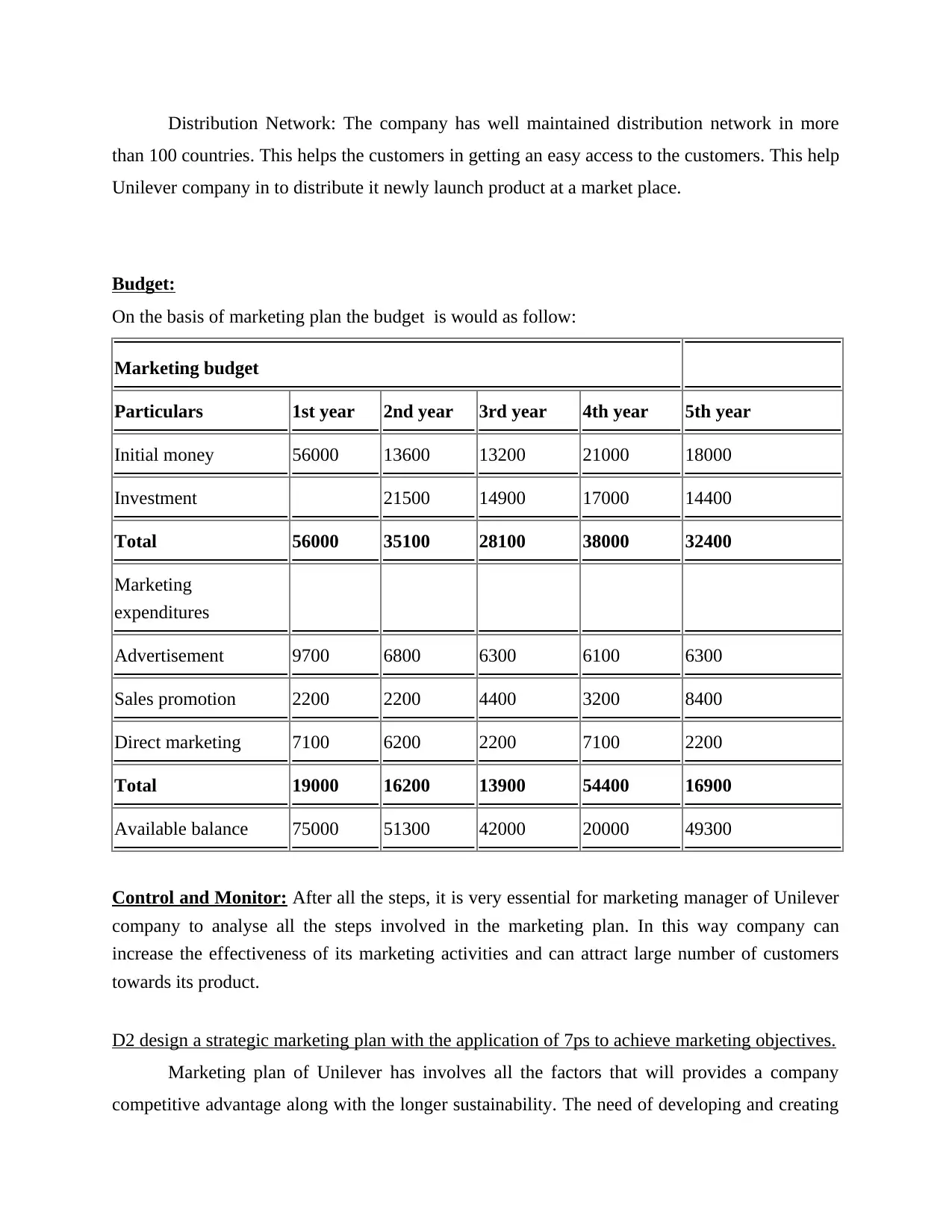
Distribution Network: The company has well maintained distribution network in more
than 100 countries. This helps the customers in getting an easy access to the customers. This help
Unilever company in to distribute it newly launch product at a market place.
Budget:
On the basis of marketing plan the budget is would as follow:
Marketing budget
Particulars 1st year 2nd year 3rd year 4th year 5th year
Initial money 56000 13600 13200 21000 18000
Investment 21500 14900 17000 14400
Total 56000 35100 28100 38000 32400
Marketing
expenditures
Advertisement 9700 6800 6300 6100 6300
Sales promotion 2200 2200 4400 3200 8400
Direct marketing 7100 6200 2200 7100 2200
Total 19000 16200 13900 54400 16900
Available balance 75000 51300 42000 20000 49300
Control and Monitor: After all the steps, it is very essential for marketing manager of Unilever
company to analyse all the steps involved in the marketing plan. In this way company can
increase the effectiveness of its marketing activities and can attract large number of customers
towards its product.
D2 design a strategic marketing plan with the application of 7ps to achieve marketing objectives.
Marketing plan of Unilever has involves all the factors that will provides a company
competitive advantage along with the longer sustainability. The need of developing and creating
than 100 countries. This helps the customers in getting an easy access to the customers. This help
Unilever company in to distribute it newly launch product at a market place.
Budget:
On the basis of marketing plan the budget is would as follow:
Marketing budget
Particulars 1st year 2nd year 3rd year 4th year 5th year
Initial money 56000 13600 13200 21000 18000
Investment 21500 14900 17000 14400
Total 56000 35100 28100 38000 32400
Marketing
expenditures
Advertisement 9700 6800 6300 6100 6300
Sales promotion 2200 2200 4400 3200 8400
Direct marketing 7100 6200 2200 7100 2200
Total 19000 16200 13900 54400 16900
Available balance 75000 51300 42000 20000 49300
Control and Monitor: After all the steps, it is very essential for marketing manager of Unilever
company to analyse all the steps involved in the marketing plan. In this way company can
increase the effectiveness of its marketing activities and can attract large number of customers
towards its product.
D2 design a strategic marketing plan with the application of 7ps to achieve marketing objectives.
Marketing plan of Unilever has involves all the factors that will provides a company
competitive advantage along with the longer sustainability. The need of developing and creating
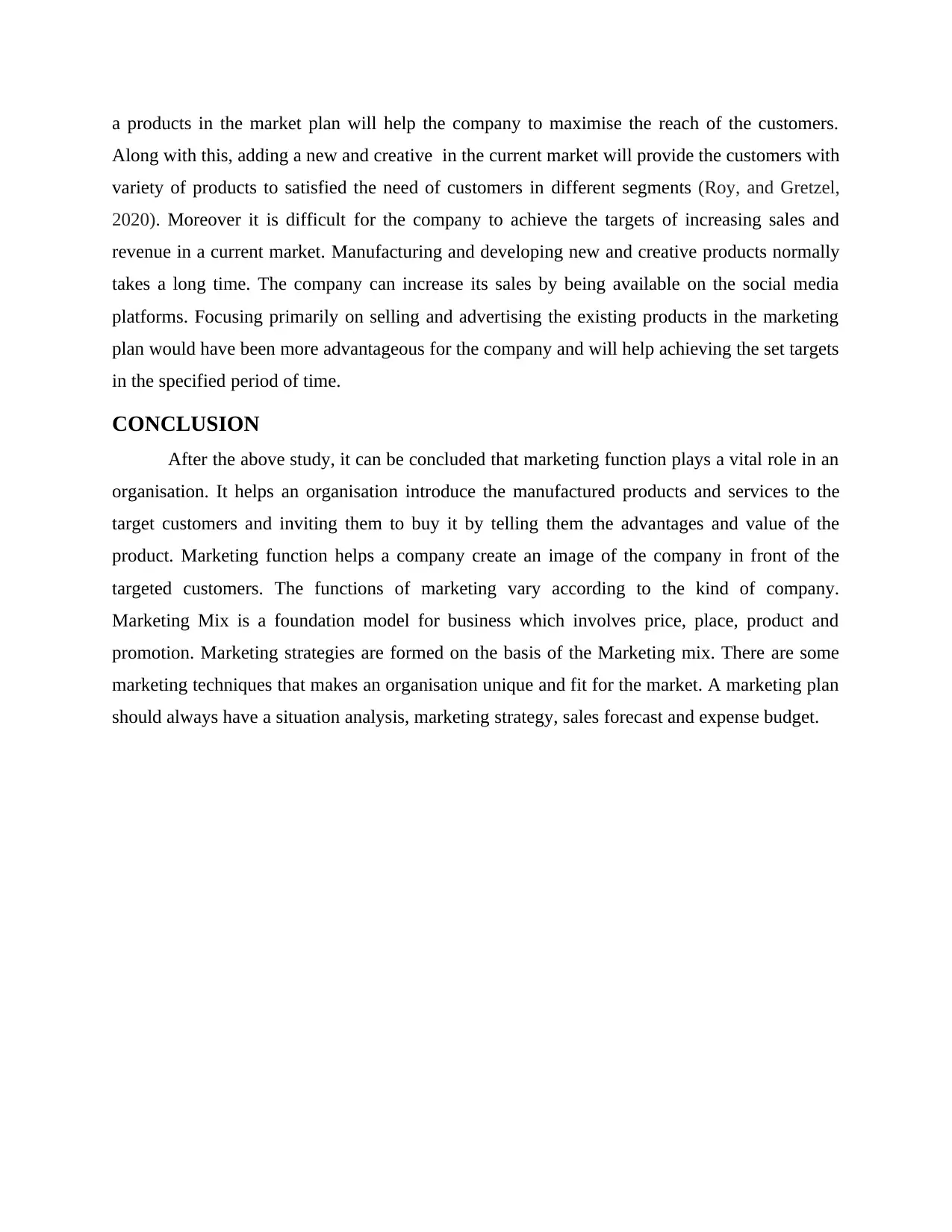
a products in the market plan will help the company to maximise the reach of the customers.
Along with this, adding a new and creative in the current market will provide the customers with
variety of products to satisfied the need of customers in different segments (Roy, and Gretzel,
2020). Moreover it is difficult for the company to achieve the targets of increasing sales and
revenue in a current market. Manufacturing and developing new and creative products normally
takes a long time. The company can increase its sales by being available on the social media
platforms. Focusing primarily on selling and advertising the existing products in the marketing
plan would have been more advantageous for the company and will help achieving the set targets
in the specified period of time.
CONCLUSION
After the above study, it can be concluded that marketing function plays a vital role in an
organisation. It helps an organisation introduce the manufactured products and services to the
target customers and inviting them to buy it by telling them the advantages and value of the
product. Marketing function helps a company create an image of the company in front of the
targeted customers. The functions of marketing vary according to the kind of company.
Marketing Mix is a foundation model for business which involves price, place, product and
promotion. Marketing strategies are formed on the basis of the Marketing mix. There are some
marketing techniques that makes an organisation unique and fit for the market. A marketing plan
should always have a situation analysis, marketing strategy, sales forecast and expense budget.
Along with this, adding a new and creative in the current market will provide the customers with
variety of products to satisfied the need of customers in different segments (Roy, and Gretzel,
2020). Moreover it is difficult for the company to achieve the targets of increasing sales and
revenue in a current market. Manufacturing and developing new and creative products normally
takes a long time. The company can increase its sales by being available on the social media
platforms. Focusing primarily on selling and advertising the existing products in the marketing
plan would have been more advantageous for the company and will help achieving the set targets
in the specified period of time.
CONCLUSION
After the above study, it can be concluded that marketing function plays a vital role in an
organisation. It helps an organisation introduce the manufactured products and services to the
target customers and inviting them to buy it by telling them the advantages and value of the
product. Marketing function helps a company create an image of the company in front of the
targeted customers. The functions of marketing vary according to the kind of company.
Marketing Mix is a foundation model for business which involves price, place, product and
promotion. Marketing strategies are formed on the basis of the Marketing mix. There are some
marketing techniques that makes an organisation unique and fit for the market. A marketing plan
should always have a situation analysis, marketing strategy, sales forecast and expense budget.
Paraphrase This Document
Need a fresh take? Get an instant paraphrase of this document with our AI Paraphraser
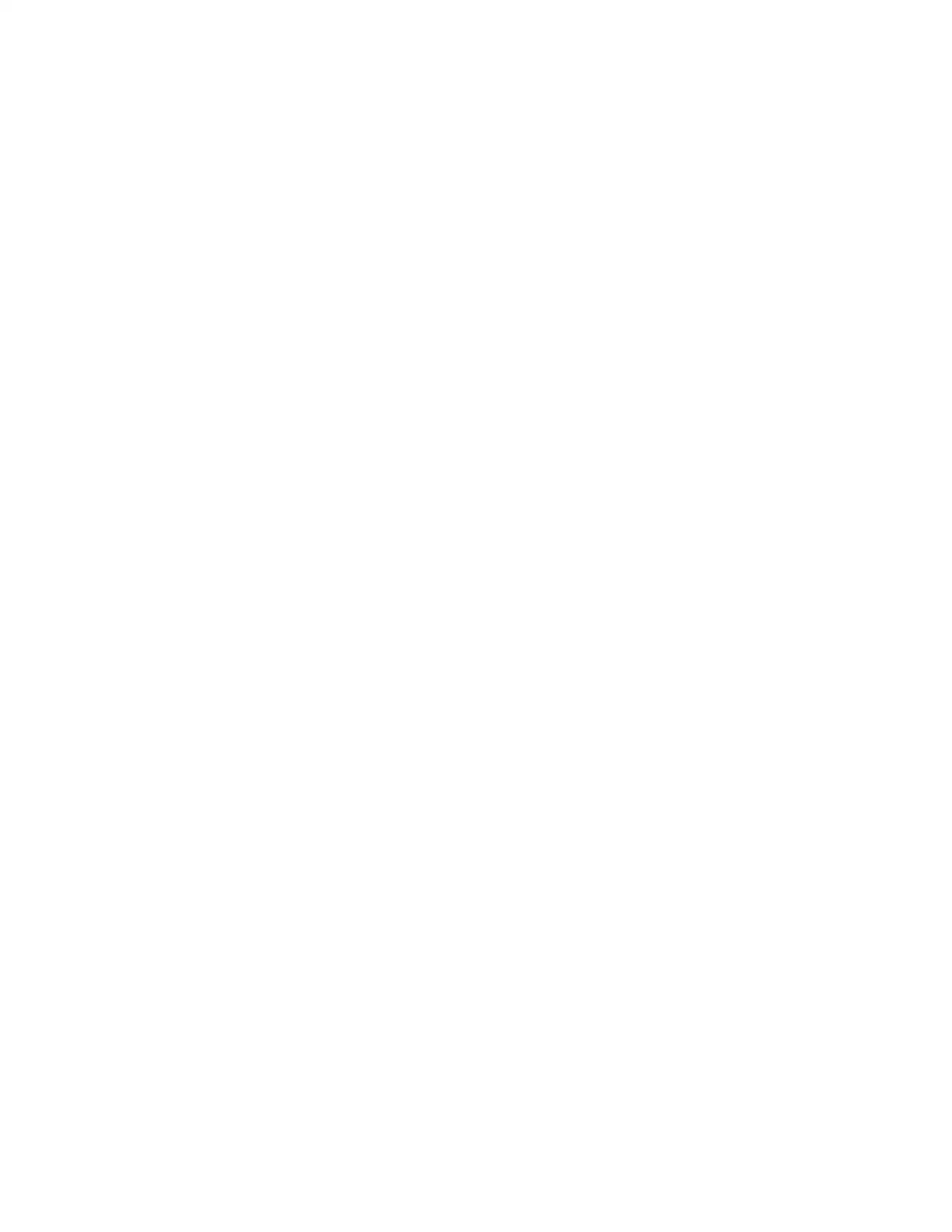
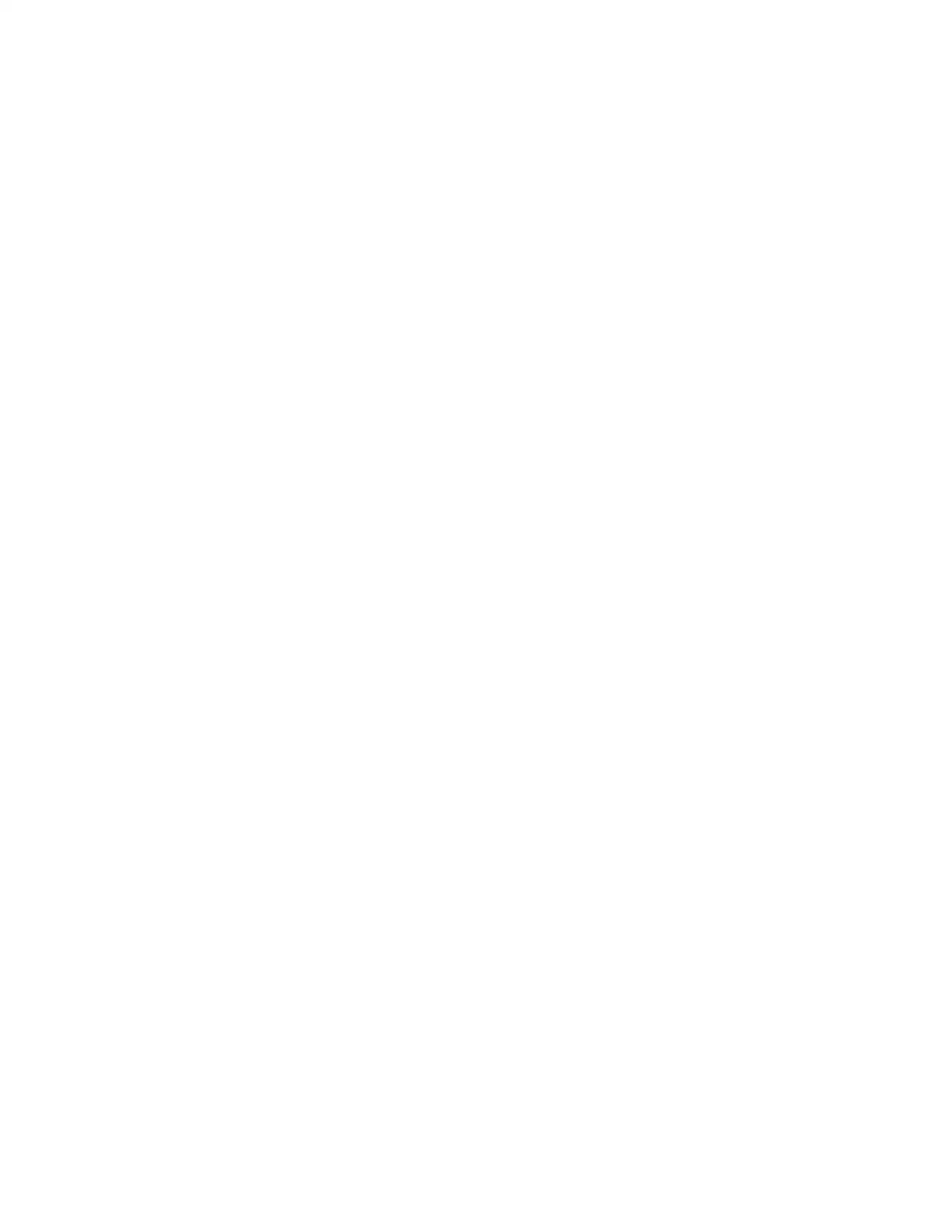
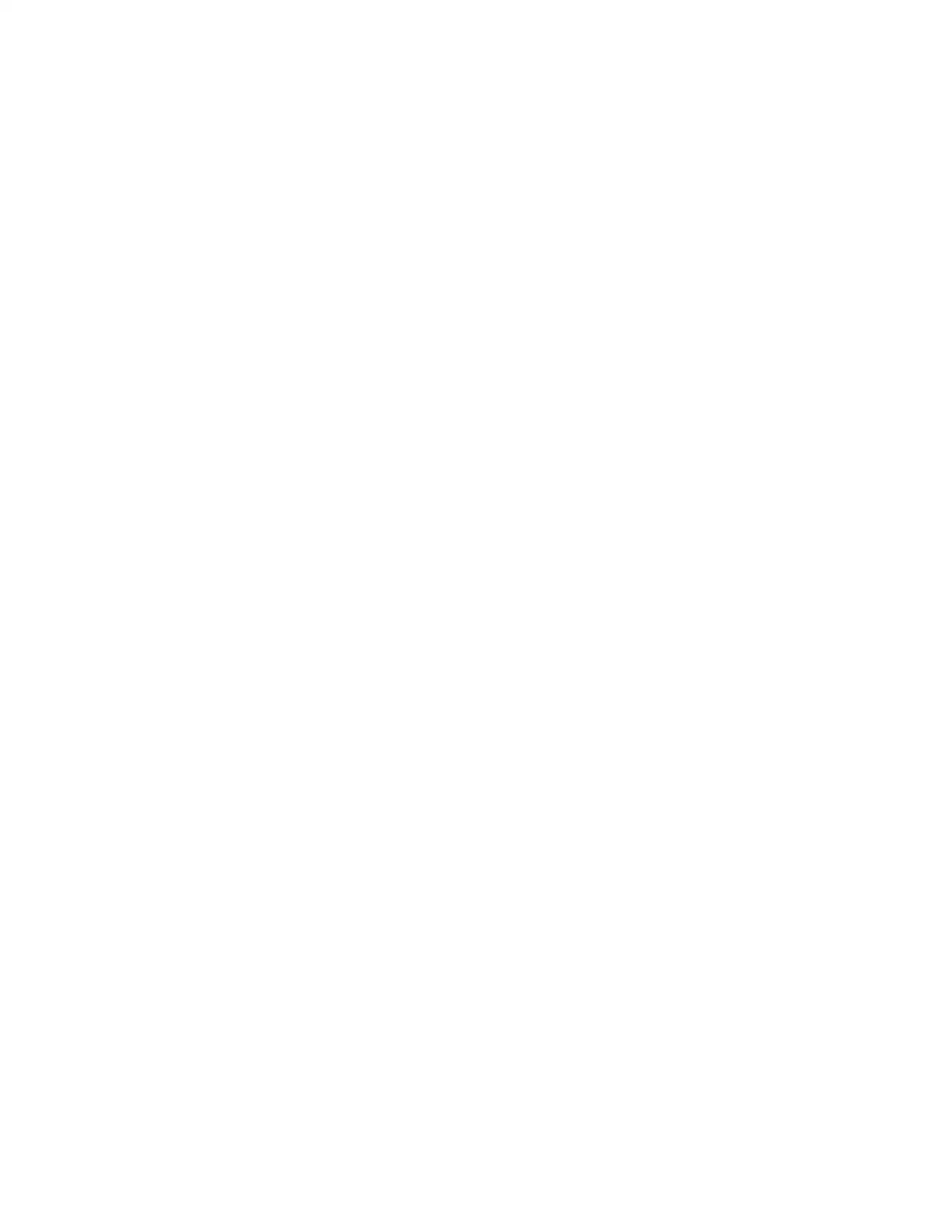
Secure Best Marks with AI Grader
Need help grading? Try our AI Grader for instant feedback on your assignments.
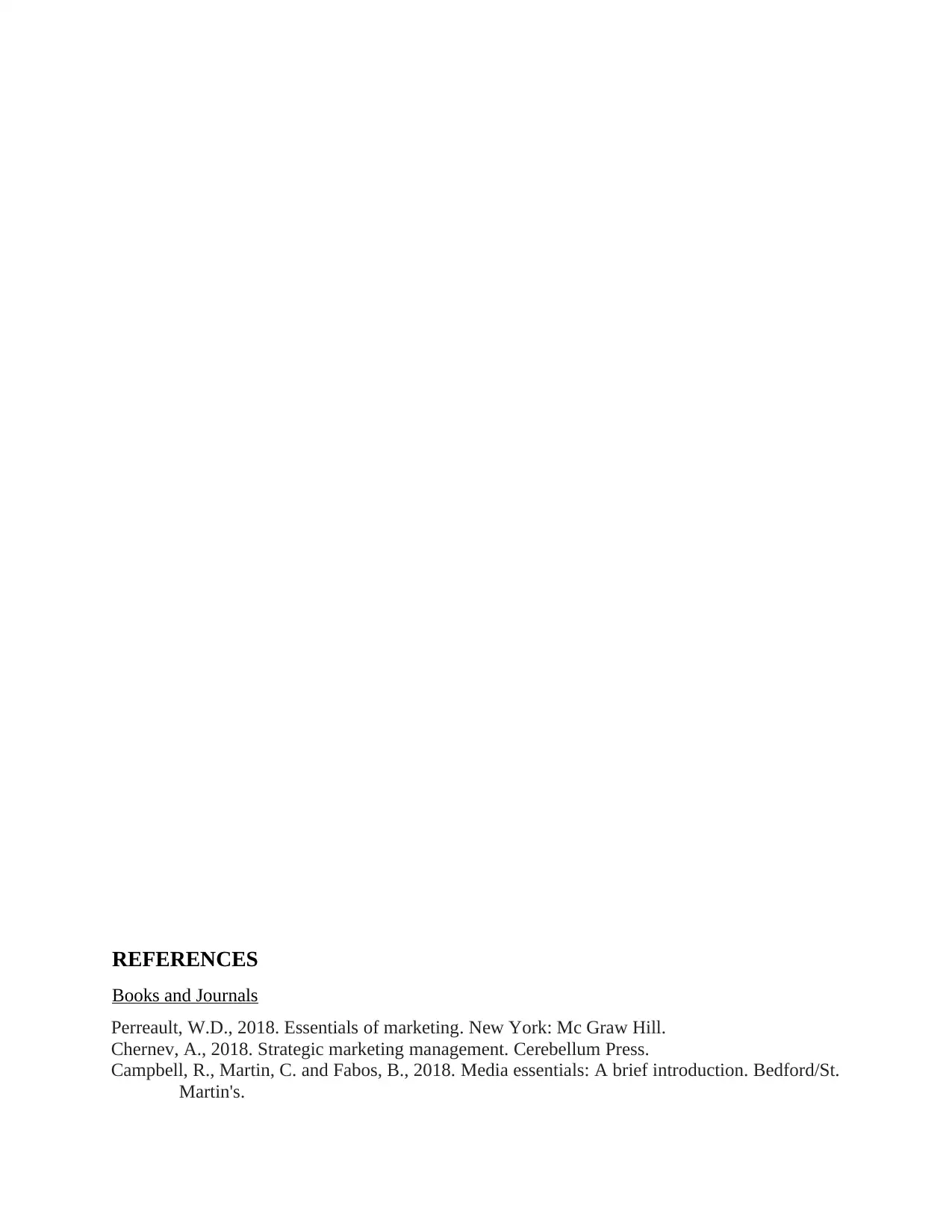
REFERENCES
Books and Journals
Perreault, W.D., 2018. Essentials of marketing. New York: Mc Graw Hill.
Chernev, A., 2018. Strategic marketing management. Cerebellum Press.
Campbell, R., Martin, C. and Fabos, B., 2018. Media essentials: A brief introduction. Bedford/St.
Martin's.
Books and Journals
Perreault, W.D., 2018. Essentials of marketing. New York: Mc Graw Hill.
Chernev, A., 2018. Strategic marketing management. Cerebellum Press.
Campbell, R., Martin, C. and Fabos, B., 2018. Media essentials: A brief introduction. Bedford/St.
Martin's.
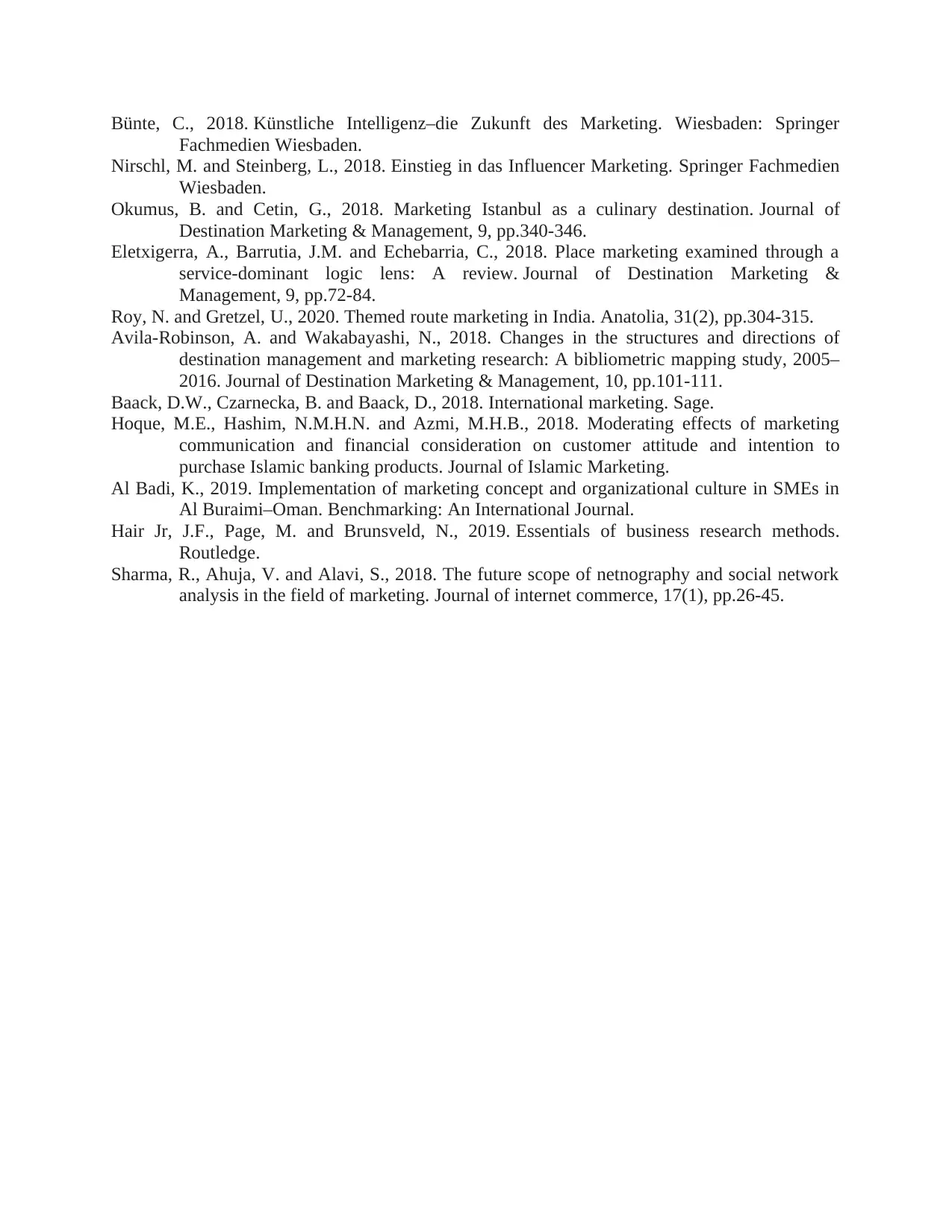
Bünte, C., 2018. Künstliche Intelligenz–die Zukunft des Marketing. Wiesbaden: Springer
Fachmedien Wiesbaden.
Nirschl, M. and Steinberg, L., 2018. Einstieg in das Influencer Marketing. Springer Fachmedien
Wiesbaden.
Okumus, B. and Cetin, G., 2018. Marketing Istanbul as a culinary destination. Journal of
Destination Marketing & Management, 9, pp.340-346.
Eletxigerra, A., Barrutia, J.M. and Echebarria, C., 2018. Place marketing examined through a
service-dominant logic lens: A review. Journal of Destination Marketing &
Management, 9, pp.72-84.
Roy, N. and Gretzel, U., 2020. Themed route marketing in India. Anatolia, 31(2), pp.304-315.
Avila-Robinson, A. and Wakabayashi, N., 2018. Changes in the structures and directions of
destination management and marketing research: A bibliometric mapping study, 2005–
2016. Journal of Destination Marketing & Management, 10, pp.101-111.
Baack, D.W., Czarnecka, B. and Baack, D., 2018. International marketing. Sage.
Hoque, M.E., Hashim, N.M.H.N. and Azmi, M.H.B., 2018. Moderating effects of marketing
communication and financial consideration on customer attitude and intention to
purchase Islamic banking products. Journal of Islamic Marketing.
Al Badi, K., 2019. Implementation of marketing concept and organizational culture in SMEs in
Al Buraimi–Oman. Benchmarking: An International Journal.
Hair Jr, J.F., Page, M. and Brunsveld, N., 2019. Essentials of business research methods.
Routledge.
Sharma, R., Ahuja, V. and Alavi, S., 2018. The future scope of netnography and social network
analysis in the field of marketing. Journal of internet commerce, 17(1), pp.26-45.
Fachmedien Wiesbaden.
Nirschl, M. and Steinberg, L., 2018. Einstieg in das Influencer Marketing. Springer Fachmedien
Wiesbaden.
Okumus, B. and Cetin, G., 2018. Marketing Istanbul as a culinary destination. Journal of
Destination Marketing & Management, 9, pp.340-346.
Eletxigerra, A., Barrutia, J.M. and Echebarria, C., 2018. Place marketing examined through a
service-dominant logic lens: A review. Journal of Destination Marketing &
Management, 9, pp.72-84.
Roy, N. and Gretzel, U., 2020. Themed route marketing in India. Anatolia, 31(2), pp.304-315.
Avila-Robinson, A. and Wakabayashi, N., 2018. Changes in the structures and directions of
destination management and marketing research: A bibliometric mapping study, 2005–
2016. Journal of Destination Marketing & Management, 10, pp.101-111.
Baack, D.W., Czarnecka, B. and Baack, D., 2018. International marketing. Sage.
Hoque, M.E., Hashim, N.M.H.N. and Azmi, M.H.B., 2018. Moderating effects of marketing
communication and financial consideration on customer attitude and intention to
purchase Islamic banking products. Journal of Islamic Marketing.
Al Badi, K., 2019. Implementation of marketing concept and organizational culture in SMEs in
Al Buraimi–Oman. Benchmarking: An International Journal.
Hair Jr, J.F., Page, M. and Brunsveld, N., 2019. Essentials of business research methods.
Routledge.
Sharma, R., Ahuja, V. and Alavi, S., 2018. The future scope of netnography and social network
analysis in the field of marketing. Journal of internet commerce, 17(1), pp.26-45.
1 out of 18
Related Documents
Your All-in-One AI-Powered Toolkit for Academic Success.
+13062052269
info@desklib.com
Available 24*7 on WhatsApp / Email
![[object Object]](/_next/static/media/star-bottom.7253800d.svg)
Unlock your academic potential
© 2024 | Zucol Services PVT LTD | All rights reserved.




